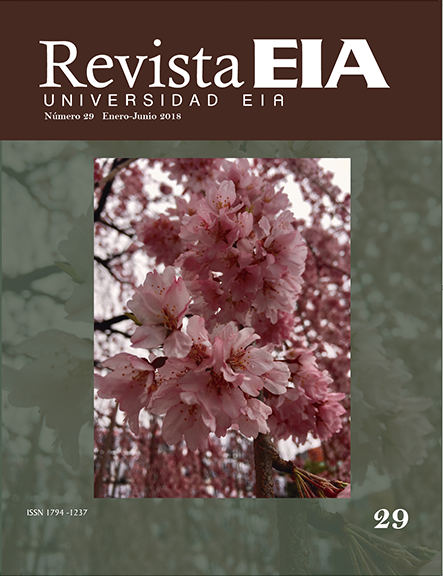Potencial de lixiviación del Clorpirifos en un Entisol colombiano
Potencial de lixiviación del Clorpirifos en un Entisol colombiano

Copyright statement
The authors exclusively assign to the Universidad EIA, with the power to assign to third parties, all the exploitation rights that derive from the works that are accepted for publication in the Revista EIA, as well as in any product derived from it and, in in particular, those of reproduction, distribution, public communication (including interactive making available) and transformation (including adaptation, modification and, where appropriate, translation), for all types of exploitation (by way of example and not limitation : in paper, electronic, online, computer or audiovisual format, as well as in any other format, even for promotional or advertising purposes and / or for the production of derivative products), for a worldwide territorial scope and for the entire duration of the rights provided for in the current published text of the Intellectual Property Law. This assignment will be made by the authors without the right to any type of remuneration or compensation.
Consequently, the author may not publish or disseminate the works that are selected for publication in the Revista EIA, neither totally nor partially, nor authorize their publication to third parties, without the prior express authorization, requested and granted in writing, from the Univeridad EIA.
Show authors biography
Article visits 810 | PDF visits 359
Downloads
- Díaz, M. y Barceló D. (2006) Chlorpyrifos, Diazinon and their major metabolites in sludge and sludge-fertilized agricultural soils, Journal of Chromatography A, 1132, pp. 21–27. 2. Edgerley, D. (1998) Techniques for improving the accuracy of calibration in the environmental laboratory, 14th Annual Waste Testing & Quality Assurance Symposium. 3. Environmental Protection Agency (2016). Human health risk assessment: Chlorpyrifos. Estados Unidos. Disponible en: https://www.regulations.gov/document?D=EPA-HQ-OPP-2015-0653-0454 [Consultado 11-12-2017]. 4. Environmental Protection Agency (2017). Pesticides industry sales and usage: 2008 and 2012 Market Estimates. Washington, DC 20460. Disponible en: https://www.epa.gov/sites/production/files/2017-01/documents/pesticides-industry-sales-usage-2016_0.pdf [Consultado 11-12-2017]. 5. Forum on Environmental Measurements (FEM-EPA) (2005) Validation and Peer Review of U.S. Environmental Protection Agency Chemical Methods of Analysis. (FEM Document Number 2005-01-EPA). Disponible en: http://www2.epa.gov/sites/production/files/2015-01/documents/chemmethod_validity_guide.pdf [Consultado 11-12-2017]. 6. Harper, S. (1994) Sorption-desorption and herbicide behavior in soil, Review, Weed Science, 6, pp. 207-255. 7. Instituto Colombiano Agropecuario (2016) Estadísticas de comercialización de plaguicidas químicos de uso agrícola 2015, Colombia. Disponible en: https://www.ica.gov.co/getdoc/1908eb2c-254f-44de-8e21-c322cc2a7e91/Estadisticas.aspx [Consultado 11-12-2017]. 8. Jaramillo, D. (2002) Introducción a la ciencia del suelo, Medellín: Universidad Nacional de Colombia. 9. Laabs, V., Amelung, W., Pint, A., Altstaedt, A. y Zech, W. (2000) Leaching and degradation of corn and soybean pesticides in an Oxisol of the Brazilian Cerrados, Chemosphere, 41, pp. 1441-1449. 10. Lavagnini, I. y Magno, F. (2006) A statistical overview on univariate calibration, inverse regression, and detection limits: Application to gas chromatography/mass spectrometry technique, Mass Spectrometry Reviews-Wiley InterScience, 26, pp. 1–18. 11. Loaiza, A., Jaramillo, J. y León, F. (2000) Incidencia de factores sociales, económicos, culturales y técnicos en el uso de agroquímicos por pequeños productores del departamento de Antioquia. Programa Nacional de Transferencia de Tecnología. PRONATTA, Instituto Colombiano Agropecuario, ICA. 12. Márquez, S. (2012) Riesgo ambiental por uso del Clorpirifos en zonas de ganadería de leche, en San Pedro de los Milagros, Colombia y Propuesta de conversión agroecológica. Tesis doctoral. Universidad de Antioquia. 13. Molina, F., Narváez, J. y Correa, S. (2016) Informe Proyecto Agroquímicos-Estudios de la problemática ambiental de tres embalses de Empresas Públicas de Medellín para la gestión integral y adecuada del recurso hídrico. Medellín. 14. Racke, K., Fontaine, D., Yoder, R. y Miller, J. (1994) Chlorpyriphos degradation in soil at termiticidal application rates, Pesticide Sciences, 42, pp. 43–51. 15. Soil Survey Division Staff (SSDS) (1993) Soil survey manual. (Handbook No. 18. United States Department of Agriculture -USDA). Washington D. C. 16. Soil Survey Staff (SSS) (2014) Keys to soil taxonomy. Twelfth Edition. USDA. Disponible en: https://www.nrcs.usda.gov/wps/portal/nrcs/detail/soils/survey/class/taxonomy/?cid=nrcs142p2_053580) [Descargado 22-01-2017]. 17. Soil Survey Staff (SSS) (2010) Soil Survey Field and Laboratory Methods Manual. Burt and SoilSurvey Staff (ed.). U.S. Department of Agriculture, Natural Resources Conservation Service. 18. Stone, W. y Wilson, J. (2006) Preferential flow estimates to an agricultural tile drain with implications for glyphosate transport, Journal of Environmental Quality, 35 (5), pp. 1825-1835. 19. Tang, X., Zhu, B. y Katou, H. (2012) A review of rapid transport of pesticides from sloping farmland to surface waters: Processes and mitigation strategies, Journal of Environmental Sciences, 24 (3), pp. 351-361. 20. Tobón, F., López, L. y Paniagua, R. (2010) Contaminación del agua por plaguicidas en un área de Antioquia, Revista de Salud Pública, 12 (2), pp. 300-307. 21. Tobón, F. y López, L. (2011) Genotoxicidad del agua contaminada por plaguicidas en un área de Antioquia, Revista MVZ Córdoba, 16 (2), pp. 2605-2615. 22. Vahos, R., Londoño, M. y Munera, G. (1997) Patogenicidad de aislamientos nativos de Metarhizium anisopliae y Beauveria bassiana sobre la chinche de los pastos Collaria sp pos, columbiensis (HEM:MIRIDAE), Medellín: Corporación Colombiana de investigación Agropecuaria y Fundación Agropecuaria Buen Pastor.




